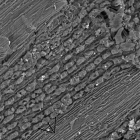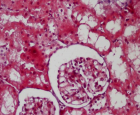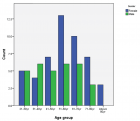Abstract
Review Article
Tree-ring history of Swiss needle cast impact on Douglas-fir growth in Western Oregon: correlations with climatic variables
E Henry Lee*, Peter A Beedlow, Ronald S Waschmann, Steve Cline, Michael Bollman, Charlotte Wickham and Nicholas Testa
Published: 25 November, 2021 | Volume 5 - Issue 3 | Pages: 076-087
The fungal pathogen, Nothophaeocryptopus gaeumannii, occurs wherever Douglas-fir is found but disease damage is believed to be limited to the Coast Range and is of no concern outside the coastal fog zone (Shaw, et al., 2011). However, knowledge remains limited on the history and spatial distribution of Swiss Needle Cast (SNC) impacts in the Pacific Northwest (PNW). We reconstructed the history of SNC impacts on mature Douglas-fir trees based on tree ringwidth chronologies from the west slope of the Coast Range to the high Cascades of Oregon. Our findings show that SNC impacts on growth occur wherever Douglas-fir is found in western Oregon and is not limited to the coastal fog zone. The spatiotemporal patterns of growth impact from SNC disease were synchronous across the region, displayed periodicities of 25-30 years, strongly correlated with winter and summer temperatures and summer precipitation, and matched the patterns of enriched cellulosic stable carbon isotope indicative of physiological stress. While winter and summer temperature and summer precipitation influenced pathogen dynamics at all sites, the primary climatic factor of these three limiting factors varied spatially by location, topography, and elevation. In the 20th century, SNC impacts at low- to mid-elevations were least severe during the warm phase of the Pacific Decadal Oscillation (PDO, 1924-1945) and most severe in 1984-1986, following the cool phase of the PDO (1945-1977). At high elevations on the west slope of the Cascade Mountains, SNC impacts were the greatest in the 1990s and 2000s, a period of warmer winter temperatures associated with climate change. Warmer winters will likely continue to increase SNC severity at higher elevations, north along the coast from northern Oregon to British Columbia, and inland where low winter temperatures currently limit growth of the pathogen. Surprisingly, tree-ring records of ancient Douglas-fir logs dated ~53K radioactive years B.P. from Eddyville, OR displayed 7.5- and 20-year periodicities of low growth, similar to those found in modern day coastal Douglas-fir tree-ring records which we interpret as being due to cyclic fluctuations in SNC severity. Our findings indicate that SNC has persisted for as long as its host, and as a result of changing climate, may become a significant forest health problem in areas of the PNW beyond the coastal fog zone.
Read Full Article HTML DOI: 10.29328/journal.jpsp.1001065 Cite this Article Read Full Article PDF
References
- Boyce JS. A needle cast of Douglas-fir associated with Adelopus gaeumannii. Phytopathol. 1940; 30: 649-659.
- Gadgil PD. Fungi on Trees and Shrubs in New Zealand. Fungal Diversity Press, Hong Kong.
- Hansen EM, Stone JK, Capitano BR, Rosso P, Sutton W, et al. Incidence and impact of Swiss needle cast in forest plantations of Douglas-fir in coastal Oregon. Plant Dis. 2000; 84: 773-778. PubMed: https://pubmed.ncbi.nlm.nih.gov/30832107/
- Omdal D, Ramsey-Kroll A. Swiss needle cast on Washington state lands, 1999-2009. Forest Health Note, 2010-001, Washington Department of Natural Resources, Olympia, WA. 2010; 4.
- Black BA, Shaw DC, Stone JK. Impacts of Swiss needle cast on overstory Douglas-fir forests of the western Oregon Coast Range. For Ecol Manag. 2010; 259: 1673-1680.
- Shaw DC, Filip GM, Kanaskie A, Maguire DA, Littke WA. Managing an epidemic of Swiss needle cast in the Douglas-fir region of Oregon: The role of the Swiss needle cast cooperative. J For 2011; 109-119.
- Kanaskie A, Norlander D, Omdal D, Ramsey A. Aerial survey results 2015 Oregon and Washington. 2000. http://sncc.forestry.oregonstate.edu/sites/default/files/Results_2015.pdf
- Manter DK, Reeser PW, Stone JK. A climate-based model for predicting geographic variation in Swiss needle cast severity in the Oregon Coast Range. Phytopathol. 2005; 95: 1256-1265. PubMed: https://pubmed.ncbi.nlm.nih.gov/18943355/
- Stone JK, Capitano BR, Kerrigan JL. The histopathology of Phaeocryptopus gaeumannii on Douglas-fir needles. Mycologia. 2008b; 100: 431-444. PubMed: https://pubmed.ncbi.nlm.nih.gov/18751550/
- Hadfield J, Douglas B. Protection of Douglas-fir Christmas trees from Swiss needle cast in Oregon. Am Christmas Tree J. 1982; 26: 31-33.
- Michaels E, Chastagner GA. Distribution, severity and impact of Swiss needle cast in Douglas-fir Christmas trees in western Washington and Oregon. Plant Dis. 1984; 68: 939-942.
- Winton LM, Hansen EM, Stone JK. Population structure suggests reproductively isolated lineages of Phaeocryptopus gaeumannii. Mycologia. 2006; 98: 781-791. PubMed: https://pubmed.ncbi.nlm.nih.gov/17256581/
- Zhao J, Mainwaring DB, Maguire DA, Kanaskie A. Regional and annual trends in Douglas-fir foliage retention: correlations with climatic variables. For Ecol Manag. 2011; 262: 1872-1886.
- Watt MS, Stone JK, Hood IA, Manning LK. Using a climatic niche model to predict the direct and indirect impacts of climate change on the distribution of Douglas-fir in New Zealand. Global Change Biol. 2011; 17: 3608-3619.
- Peace TR. Pathology of Trees and Shrubs. Oxford University Press, Oxford, UK. 1962.
- Hood IA. Phaeocryptopus gaeumannii on Pseudotsuga menziesii in southern British Columbia. N Z J Sci. 1962; 12: 415-424.
- Lee EH, Beedlow PA, Waschmann RS, Burdick CA, Shaw DC. Tree-ring analysis of the fungal disease Swiss needle cast in Western Oregon coastal forests. Can J For Res. 2013; 43: 677-690.
- Hagle SK, Gibson KE, Tunnock S. Field guide to diseases and insect pests of northern & central Rocky Mountain conifers. Report No. R1-03-08. (Reprinted in 2013 with minor revisions; B.A. Fergusen, Montana DNRC ed.). U.S. Department of Agriculture, Forest Service, State and Private Forestry, Northern and Intermountain Regions; Missoula, Montana, and Ogden, Utah. 2003; 197. http://dnrc.mt.gov/divisions/forestry/docs/assistance/pests/fieldguide/complete-field-guide/fg-full-temp.pdf
- Filip G, Kanaskie A, Littke W, Browning J, Hildebrand D, et al. Five-year impacts of Swiss needle cast on Douglas-fir in interior forests of Oregon, USA. Acta Silv Lign Hung Spec. 2007; 23-29.
- Maguire DA, Kanaskie A, Voelker W, Johnson R, Johnson G. Growth of young Douglas-fir plantations across a gradient in Swiss needle cast severity. West J Appl For. . 2002; 17: 86-95.
- Saffell BJ, Meinzer FC, Voelker SL, Shaw DC, Brooks R, et al. Tree-ring stable isotopes record the impact of a foliar fungal pathogen on CO2 assimilation and growth in Douglas-fir. Plant Cell Environ. 2014; 37: 1536-1547. PubMed: https://pubmed.ncbi.nlm.nih.gov/24330052/
- Hood IA, Kershaw DJ. Distribution and infection period of Phaeocryptopus gaeumannii in New Zealand. N Z J For Sci. 1975; 5: 201-208.
- Capitano B. The infection and colonization of Douglas-fir by P. gaeumannii. MS thesis, Department of Botany and Plant Pathology, Oregon State University, Corvallis, Oregon. 1999. http://sncc.forestry.oregonstate.edu/sites/default/files/CapitanoBryanR1999.pdf
- Panyushkina I, Van de Water P, Jull AT, Leavitt SW, Testa NR, et al. High-resolution terrestrial MIS3 environment from trees encapsulated in landslide deposits of Oregon, USA. Abstract, Quaternary International. 2012; 367-368.
- Gedalof ZE, Peterson DL, Mantua NJ. Columbia river flow and drought since 1750. J Amer Water Res Assoc. 2004; 1579-1592.
Figures:

Figure 1

Figure 2

Figure 3

Figure 4

Figure 5

Figure 6

Figure 7

Figure 8

Figure 9

Figure 10

Figure 11

Figure 12

Figure 13

Figure 14
Similar Articles
-
Impact of Calcium Phosphate Nanoparticles on Rice PlantHrishikesh Upadhyaya*,Lutfa Begum,Bishal Dey,P K Nath,S K Panda. Impact of Calcium Phosphate Nanoparticles on Rice Plant. . 2017 doi: 10.29328/journal.jpsp.1001001; 1: 001-010
-
The Effects of Pharmacological Carbonic Anhydrase Suppression on Defence Responses of Potato Leaves To Phytophthora InfestansMagdalena Arasimowicz-Jelonek*,Jolanta Floryszak-Wieczorek. The Effects of Pharmacological Carbonic Anhydrase Suppression on Defence Responses of Potato Leaves To Phytophthora Infestans. . 2017 doi: 10.29328/journal.jpsp.1001002; 1: 011-025
-
Phytochemical content of leaf and stem of Marsilea quadrifolia (L.)Rajangam Udayakumar*,Karikalan Gopalakrishnan. Phytochemical content of leaf and stem of Marsilea quadrifolia (L.). . 2017 doi: 10.29328/journal.jpsp.1001003; 1: 026-037
-
Antagonistic features displayed by Plant Growth Promoting Rhizobacteria (PGPR): A ReviewMohsin Tariq*,Muhammad Noman,Temoor Ahmed,Amir Hameed,Natasha Manzoor,Marriam Zafar. Antagonistic features displayed by Plant Growth Promoting Rhizobacteria (PGPR): A Review . . 2017 doi: 10.29328/journal.jpsp.1001004; 1: 038-043
-
Wild-type Agrobacterium rhizogenes-mediated gene transfer in plants: Agrobacterium virulence and selection of transformantsShu Wei*,Muhammad Abdullah,Ferdinand L Shamalla,Mohammad M Rana. Wild-type Agrobacterium rhizogenes-mediated gene transfer in plants: Agrobacterium virulence and selection of transformants. . 2017 doi: 10.29328/journal.jpsp.1001005; 1: 044-051
-
Effects of Vochysia haenkeana extract on the neuromuscular blockade induced by Bothrops jararaca venom on chick biventer cervicis preparation in vitroYoko Oshima-Franco*,Fernanda Dias da Silva,Natália Tribuiani,Isadora Caruso Fontana Oliveira,Regina Yuri Hashimoto Miura,Rafael S Floriano,Márcio Galdino dos Santos,Sandro Rostelato-Ferreira. Effects of Vochysia haenkeana extract on the neuromuscular blockade induced by Bothrops jararaca venom on chick biventer cervicis preparation in vitro. . 2017 doi: 10.29328/journal.jpsp.1001006; 1: 052-058
-
HBV: Genomic Structure, HBVsAg Isolation and innovative Virotherapy Initiation in the Middle EastAboul-Ata E Aboul-Ata*,Essam M Janahi,I M El-Kalamawy,Kathleen Hefferon,Amal Mahmoud. HBV: Genomic Structure, HBVsAg Isolation and innovative Virotherapy Initiation in the Middle East . . 2017 doi: 10.29328/journal.jpsp.1001007; 1: 059-061
-
Physiological impact of Zinc nanoparticle on germination of rice (Oryza sativa L) seedUpadhyaya H*,Roy H,Shome S,Tewari S,Bhattacharya MK,Panda SK. Physiological impact of Zinc nanoparticle on germination of rice (Oryza sativa L) seed . . 2017 doi: 10.29328/journal.jpsp.1001008; 1: 062-070
-
Effects of Site Factors on the Clonal Growth of Phyllostachys bambusoides f. shouzhu YiXiaohong Gan*,Lijuan Chen,Cuibin Tang,Xia Zhang. Effects of Site Factors on the Clonal Growth of Phyllostachys bambusoides f. shouzhu Yi. . 2017 doi: 10.29328/journal.jpsp.1001009; 1: 071-079
-
Evaluation of genetic diversity in germplasm of paprika (Capsicum spp.) using random amplified polymorphic DNA (RAPD) markersRueda-Puente EO*,Renganathan P,Ruíz-Alvarado C,Hernández-Montiel LG,Prasath Duraisamy. Evaluation of genetic diversity in germplasm of paprika (Capsicum spp.) using random amplified polymorphic DNA (RAPD) markers. . 2017 doi: 10.29328/journal.jpsp.1001010; 1: 080-086
Recently Viewed
-
Mapping the Psychosocial: Introducing a Standardised System to Improve Psychosocial Understanding within Mental HealthMatthew Bretton Oakes*. Mapping the Psychosocial: Introducing a Standardised System to Improve Psychosocial Understanding within Mental Health. Arch Psychiatr Ment Health. 2024: doi: 10.29328/journal.apmh.1001051; 8: 012-019
-
Human Performance Augmenting Drugs and TechnologiesR Dinesh Kumar*. Human Performance Augmenting Drugs and Technologies. J Forensic Sci Res. 2024: doi: 10.29328/journal.jfsr.1001069; 8: 089-103
-
Methodology for Studying Combustion of Solid Rocket Propellants using Artificial Neural NetworksVictor Abrukov*, Weiqiang Pang, Darya Anufrieva. Methodology for Studying Combustion of Solid Rocket Propellants using Artificial Neural Networks. Ann Adv Chem. 2024: doi: 10.29328/journal.aac.1001048; 8: 001-007
-
The bio-energy transport in the protein molecules and its experimental validations of correctnessPang Xiao-Feng*. The bio-energy transport in the protein molecules and its experimental validations of correctness. Ann Proteom Bioinform. 2018: doi: 10.29328/journal.apb.1001004; 2: 001-048
-
Laparoscopic approach for acute right iliac fossa pathology: Our experienceLuciano Onofrio*,Gianfausto Iarrobino. Laparoscopic approach for acute right iliac fossa pathology: Our experience. Arch Surg Clin Res. 2020: doi: 10.29328/journal.ascr.1001055; 4: 054-058
Most Viewed
-
Evaluation of Biostimulants Based on Recovered Protein Hydrolysates from Animal By-products as Plant Growth EnhancersH Pérez-Aguilar*, M Lacruz-Asaro, F Arán-Ais. Evaluation of Biostimulants Based on Recovered Protein Hydrolysates from Animal By-products as Plant Growth Enhancers. J Plant Sci Phytopathol. 2023 doi: 10.29328/journal.jpsp.1001104; 7: 042-047
-
Sinonasal Myxoma Extending into the Orbit in a 4-Year Old: A Case PresentationJulian A Purrinos*, Ramzi Younis. Sinonasal Myxoma Extending into the Orbit in a 4-Year Old: A Case Presentation. Arch Case Rep. 2024 doi: 10.29328/journal.acr.1001099; 8: 075-077
-
Feasibility study of magnetic sensing for detecting single-neuron action potentialsDenis Tonini,Kai Wu,Renata Saha,Jian-Ping Wang*. Feasibility study of magnetic sensing for detecting single-neuron action potentials. Ann Biomed Sci Eng. 2022 doi: 10.29328/journal.abse.1001018; 6: 019-029
-
Pediatric Dysgerminoma: Unveiling a Rare Ovarian TumorFaten Limaiem*, Khalil Saffar, Ahmed Halouani. Pediatric Dysgerminoma: Unveiling a Rare Ovarian Tumor. Arch Case Rep. 2024 doi: 10.29328/journal.acr.1001087; 8: 010-013
-
Physical activity can change the physiological and psychological circumstances during COVID-19 pandemic: A narrative reviewKhashayar Maroufi*. Physical activity can change the physiological and psychological circumstances during COVID-19 pandemic: A narrative review. J Sports Med Ther. 2021 doi: 10.29328/journal.jsmt.1001051; 6: 001-007

HSPI: We're glad you're here. Please click "create a new Query" if you are a new visitor to our website and need further information from us.
If you are already a member of our network and need to keep track of any developments regarding a question you have already submitted, click "take me to my Query."























































































































































